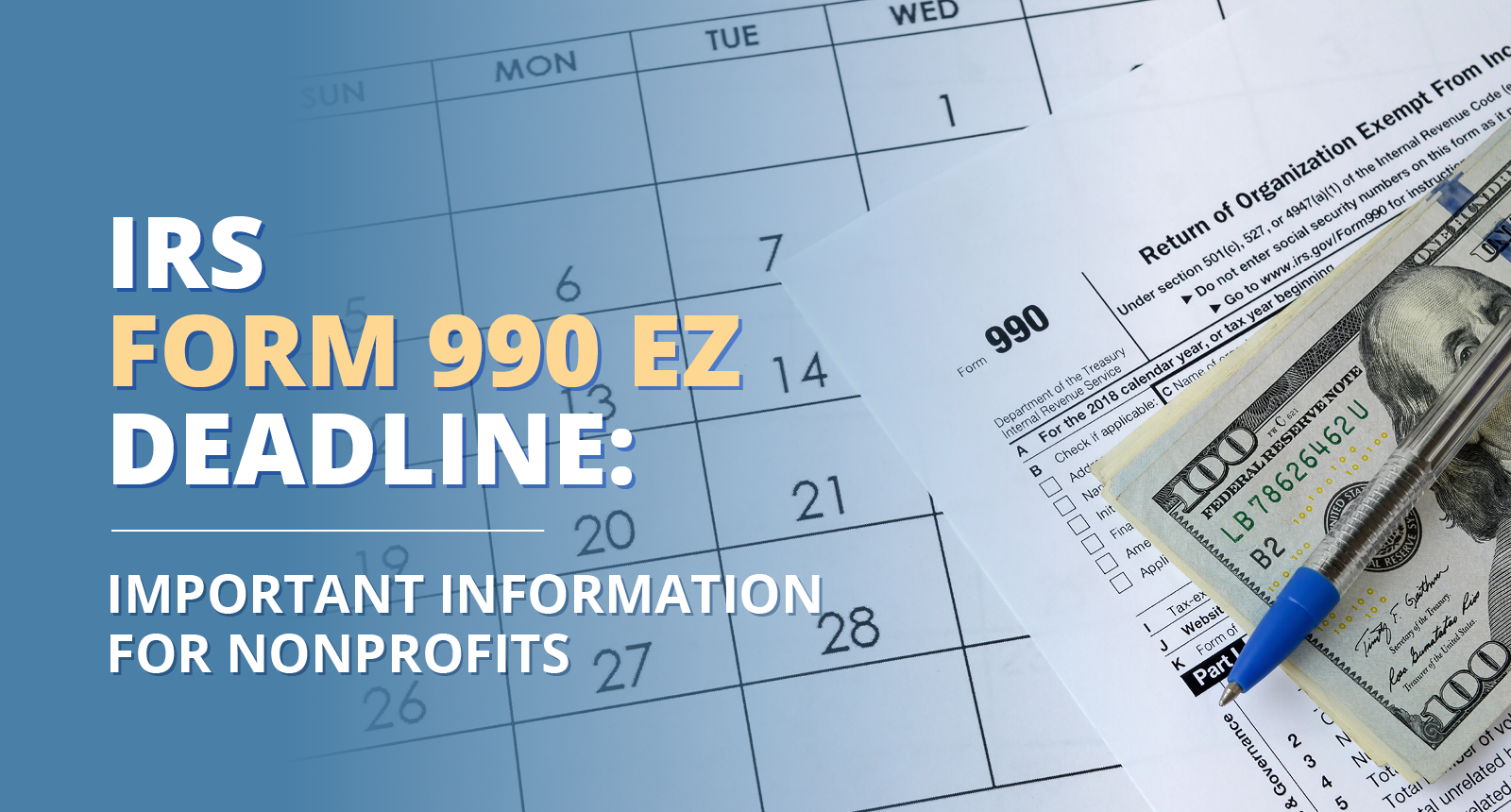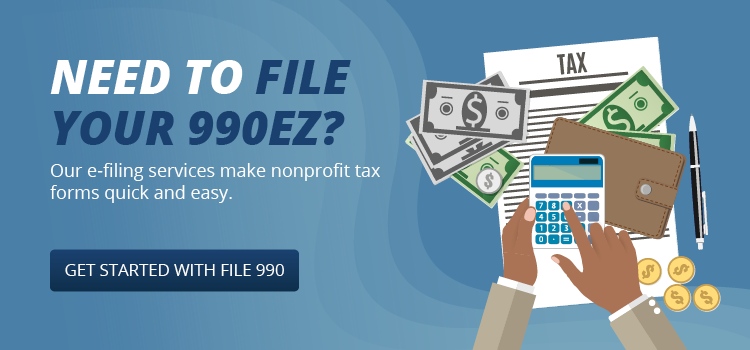IRS Form 990EZ Deadline: Important Information for 2025
September 30, 2024 | 990-EZ, 990 deadline, file 990 filing, 990EZ | 0 Comments

If you’re a mid-sized nonprofit, filling out the standard Form 990 might feel overwhelming and time-consuming. Fortunately, there’s a form meant specifically to streamline your tax season—Form 990EZ.
According to the IRS, this form is meant for organizations that make less than $200,000 in gross annual revenue and own less than $500,000 in assets. However, filling out the form is only the first step in maintaining compliance and your tax-exempt status (also known as 501(c)(3) exemption).
In this guide, we’ll review one of the most common pitfalls midsized nonprofits encounter—late submission. While this error can significantly impact your organization’s financial situation, it’s completely avoidable. Let’s explore some strategies for submitting your Form 990EZ on time.
When is the upcoming 2025 990EZ deadline?
The short answer is, it depends. However, the general rule of thumb is that nonprofits must file Form 990 EZ by the 15th day of the 5th month after their fiscal year ends. Most nonprofits choose to operate on the calendar fiscal year, meaning the filing deadline is May 15th. Consult this table to find out what your filing deadline is:
|
Ending date of tax year |
Initial return due date |
Extended due date |
|
December 31 |
May 15 |
November 15 |
|
November 30 |
April 15 |
October 15 |
|
October 31 |
March 15 |
September 15 |
|
September 30 |
February 15 |
August 15 |
|
August 31 |
January 15 |
July 15 |
|
July 31 |
December 15 |
June 15 |
|
June 30 |
November 15 |
May 15 |
|
May 31 |
October 15 |
April 15 |
|
April 30 |
September 15 |
March 15 |
|
March 31 |
August 15 |
February 15 |
|
February 28/29 |
July 15 |
January 15 |
|
January 31 |
June 15 |
December 15 |
Note that there’s also an extended due date if you can’t submit your forms on time—more on how to request an extension later.
Penalties for Missing the Form 990EZ Deadline
As the core documentation for your nonprofit’s financial activities, it’s crucial that you submit your form on time. Otherwise, you might experience the following challenges and penalties, according to the IRS:
.png?width=1590&height=880&name=990ez%20deadline%20-%20penalties%20(1).png)
1. A fine of at least $20 per day
If your nonprofit misses its filing deadline, the IRS will automatically assess the following fines:
- $20 per day for each day the return is late.
- A maximum penalty of $10,000 or 5% of your organization’s gross receipts—whichever is less.
2. Potential loss of tax-exempt status
While the aforementioned fines can significantly reduce your fundraising revenue, the biggest threat to your nonprofit’s success is the prospect of losing your tax-exempt status. If you fail to file your annual tax form for three consecutive years, you’ll lose your tax exemption status.
To put this into perspective, a nonprofit with $300,000 in gross receipts would need to pay between $60,000 and $80,000 in taxes, depending on specific tax deductions and where the organization is located. Plus, your donors wouldn’t get to deduct their donations from their own taxes, which is a major motivation to give.
3. Additional fees for reapplying for tax-exempt status
If your nonprofit loses your tax-exempt status, you can apply to reinstate it. However, reinstating your exemption status isn’t free. The user fee for filing a Form 1023 (the main application form) is $600. If you’re eligible to file a Form 1023EZ (the abridged version of 1023 meant for nonprofits with under $50,000 in gross receipts), that fee is dropped to $275.
But still, why would you pay these fees if you don’t absolutely need to? It’s much better and easier to avoid the situation by ensuring that you file your tax forms each year, preferably by the defined deadline.
Other challenges
Besides IRS-enforced penalties, your nonprofit might experience the following adverse effects from missing your Form 990-EZ deadline:- Lost supporter trust. Your nonprofit relies on supporter trust to thrive. Losing your 501(c)(3) status can discourage supporters from donating or volunteering again.
- Reputational damage. Many nonprofits thrive off of community partnerships with other nonprofits and businesses. However, losing 501(c)(3) status can signal that you’re unreliable and need to improve your management strategies.
- Challenges securing funding. Some grantmakers or sponsors require up-to-date Form 990EZs to consider nonprofits for funding—and even if they don’t, it can be a red flag for funders when they can’t access your nonprofit's financial record.
- Increased scrutiny from the IRS. Even if you successfully reapply and regain your 501(c)(3) funding status, the IRS might require internal audits of your nonprofit more often to ensure you’re remaining compliant, which can disrupt your daily operations.
All of these challenges can jeopardize your nonprofit’s future, but by filing your Form 990-EZ by the deadline, you won’t have anything to worry about.
How to Mitigate the Impacts of a Missed 990EZ Deadline
If you submit your Form 990 EZ after the deadline, you might still be able to avoid the most severe penalties from the IRS by requesting an abatement of penalties. According to the IRS, the request should be made as an attachment to Form 990-EZ and answer the following questions:
- What prevented you from requesting an extension before the deadline?
- How can you demonstrate that you weren’t simply being careless and had an extenuating circumstance that made you miss the deadline?
- What steps have been taken to prevent this from happening again in the future?
Be as detailed as possible and include evidence to support your claims. It’s even better if you include supporting documents, such as financial statements and board meeting minutes—just ensure these documents are allowed to be shared publicly.
After you’ve mailed a letter to the IRS, the next step is to submit your 990EZ correctly as soon as possible. The IRS will either approve your request and waive the fees, or they’ll assess the fees for every day until it receives your correct 990 EZ.
How to Meet Your 990EZ Deadline
Now that you know about the fees and additional work that accompanies missing your filing deadline, it’s important to take steps to make sure it never happens again. Improve your overall approach to nonprofit tax filing with these tips:

- Gather information proactively. Saving your work to a month before your deadline can cause undue stress and errors. Avoid this and keep your tax season as efficient as possible by storing and organizing financial documents in a central and secure database throughout the year.
- Use an IRS-certified e-file provider. Did you know that you must use a digital e-file provider to submit your taxes? Not to worry—the best e-file providers (our favorite is File 990) actually streamline your workflow and are affordable to nonprofits. Plus, it’s much faster than sending your forms via snail mail, making it easier to hit your deadline.
- Fill out Form 8868. If you foresee your nonprofit being unable to submit your form on time, you can avoid any penalties by filling out IRS Form 8868. If approved, the IRS will shift your deadline to six months in the future, giving your nonprofit time to collect the correct information.
If you continue to miss your deadlines, you might consider working with a nonprofit consultant or financial expert. However, bear in mind that these professionals can be expensive, which might add to any financial burden posed by IRS penalties. IRS-certified efile providers are more affordable and user-friendly than hiring a consultant or internal financial professional, so start there before making any larger financial decisions.
Wrapping Up
Ultimately, for nonprofits, the tasks and organizational strategies usually associated with tax season should be in place all year. Using the right technology, remaining diligent about your deadline, and organizing your records will put you ahead of the curve come tax season.
Additional Resources
- File a 990 N Postcard with File 990. Are you a smaller nonprofit looking for help with your Form 990-N? Get started with the best e-file provider for nonprofits, File 990.
- E-file Form 990N Postcard: How-to Guide for Small Nonprofits. Learn everything you need to know about how to comply with the IRS as a small nonprofit in this guide.
- 990-EZ vs 990-N: How to Tell the Difference + Other FAQs. These two forms, while similar, are different and appeal to separate types of nonprofits. Confirm where your nonprofit falls on the spectrum and get your questions answered in this guide
Written by Bradley Olson

Bradley Olson is the Marketing Manager at File 990, a leading nonprofit tax filing solution for small and mid-sized nonprofits. Bradley is passionate about providing nonprofits with straightforward solutions to complicated tax-filing challenges, which empowers them to achieve their missions and establish themselves in their communities. Bradley’s 15 years of marketing experience and 25 years working for for-profit and nonprofit verticals set him apart as a thought leader in nonprofit tax filing.


